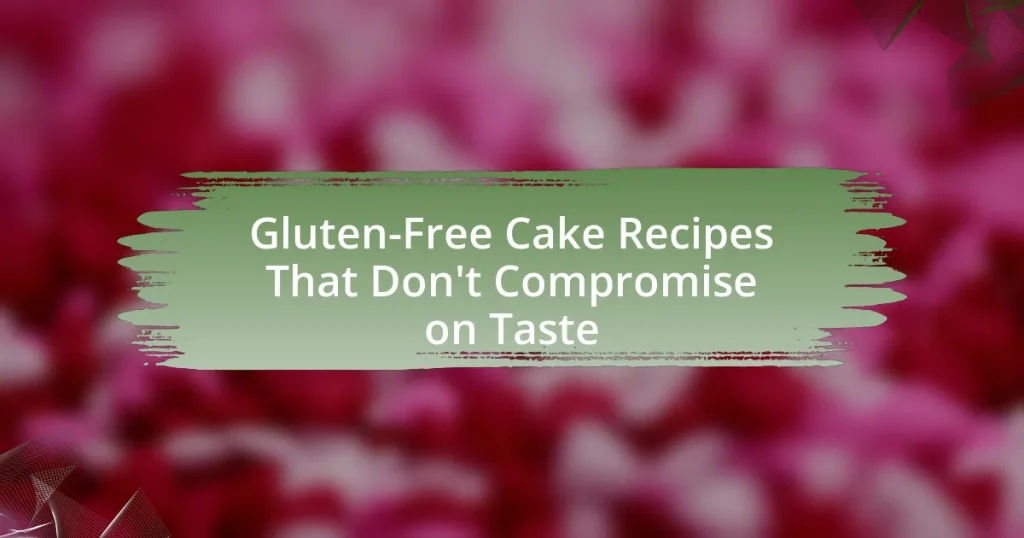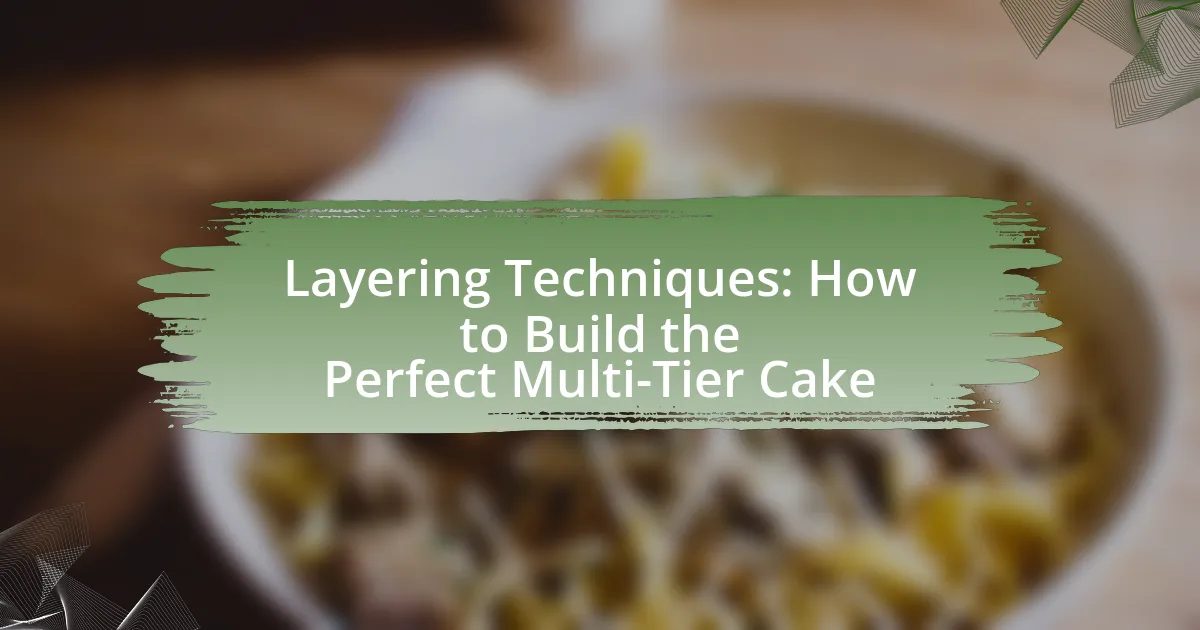Gluten-free cake recipes that deliver on taste include options such as almond flour chocolate cake, coconut flour vanilla cake, and gluten-free carrot cake. These recipes utilize alternative flours, which not only provide unique flavors and textures but also ensure a satisfying dessert experience. The article explores the differences between gluten-free and traditional cakes, common ingredients used in gluten-free baking, and how to enhance flavor and moisture. Additionally, it addresses misconceptions about gluten-free cakes, offers troubleshooting tips for common baking issues, and presents unique flavor ideas to elevate gluten-free desserts.
What are Gluten-Free Cake Recipes That Don’t Compromise on Taste?
Gluten-free cake recipes that don’t compromise on taste include almond flour chocolate cake, coconut flour vanilla cake, and gluten-free carrot cake. These recipes utilize alternative flours that provide rich flavors and moist textures, ensuring a satisfying dessert experience. For instance, almond flour adds a nutty flavor and moisture, while coconut flour offers a light, fluffy texture. A study published in the Journal of Food Science found that cakes made with almond flour had higher consumer acceptance due to their taste and texture compared to traditional gluten-free options.
How do gluten-free cakes differ from traditional cakes?
Gluten-free cakes differ from traditional cakes primarily in their use of alternative flours instead of wheat flour, which contains gluten. Traditional cakes rely on gluten for structure and texture, while gluten-free cakes utilize ingredients like almond flour, coconut flour, or rice flour, which do not contain gluten. This difference affects the cake’s density, moisture, and crumb, often resulting in a denser texture in gluten-free cakes. Additionally, gluten-free cakes may require binding agents such as xanthan gum or eggs to mimic the elasticity provided by gluten in traditional recipes.
What ingredients are commonly used in gluten-free cake recipes?
Common ingredients in gluten-free cake recipes include almond flour, coconut flour, rice flour, and gluten-free baking powder. These flours serve as substitutes for traditional wheat flour, providing structure and texture to the cake. Almond flour is rich in protein and healthy fats, while coconut flour adds moisture and a subtle sweetness. Rice flour is often used for its lightness and ability to absorb moisture, and gluten-free baking powder ensures the cake rises properly without gluten. These ingredients collectively contribute to the flavor and consistency of gluten-free cakes, allowing them to maintain a satisfying taste and texture.
How do gluten-free flours affect the texture and flavor of cakes?
Gluten-free flours significantly alter the texture and flavor of cakes by replacing traditional wheat flour, which contains gluten that provides structure and elasticity. The absence of gluten often results in a denser and crumblier texture, as gluten-free flours like almond, coconut, or rice flour do not have the same binding properties. Additionally, these alternative flours can impart distinct flavors; for instance, almond flour adds a nutty taste, while coconut flour contributes a subtle sweetness. Research indicates that the combination of different gluten-free flours can improve the overall texture and flavor profile of cakes, allowing for a more palatable final product.
Why is taste important in gluten-free baking?
Taste is crucial in gluten-free baking because it directly influences consumer acceptance and enjoyment of the final product. Gluten-free baked goods often face skepticism regarding their flavor and texture compared to traditional options, making it essential for recipes to deliver a satisfying taste to encourage repeat purchases and positive reviews. Research indicates that taste is a primary factor in food preferences, with studies showing that flavor significantly impacts overall satisfaction and willingness to recommend gluten-free products to others. Therefore, achieving a delicious taste in gluten-free baking not only enhances the eating experience but also helps to establish a market for gluten-free alternatives.
What are common misconceptions about gluten-free cakes and taste?
Common misconceptions about gluten-free cakes include the belief that they are always dry, dense, or lacking in flavor. In reality, many gluten-free cakes can be moist and flavorful when made with the right combination of gluten-free flours, such as almond or coconut flour, and additional ingredients like eggs and fats that enhance texture and taste. Research indicates that gluten-free baked goods can achieve comparable taste and texture to their gluten-containing counterparts when proper techniques and quality ingredients are utilized. For instance, a study published in the Journal of Food Science found that gluten-free cakes made with a blend of flours and starches can yield a product that is both palatable and appealing to consumers.
How can flavor be enhanced in gluten-free cakes?
Flavor in gluten-free cakes can be enhanced by incorporating ingredients such as natural extracts, spices, and high-quality cocoa. Using vanilla extract, almond extract, or citrus zest can significantly elevate the taste profile. Additionally, spices like cinnamon, nutmeg, or cardamom add depth and warmth to the flavor. High-quality cocoa powder or chocolate can also contribute richness and complexity. Studies show that the use of these flavor-enhancing ingredients can improve overall sensory perception in baked goods, making gluten-free cakes more enjoyable without compromising texture or moisture.

What are the best gluten-free cake recipes to try?
The best gluten-free cake recipes to try include almond flour chocolate cake, coconut flour vanilla cake, and gluten-free carrot cake. Almond flour chocolate cake is rich and moist, utilizing almond flour for a nutty flavor and texture. Coconut flour vanilla cake offers a light and fluffy option, with coconut flour providing a unique taste and moisture retention. Gluten-free carrot cake combines grated carrots with gluten-free flour blends, resulting in a deliciously spiced cake that remains tender. These recipes are popular among gluten-free bakers for their ability to deliver exceptional taste and texture without compromising on quality.
How can I make a delicious gluten-free chocolate cake?
To make a delicious gluten-free chocolate cake, use a combination of gluten-free flour, cocoa powder, sugar, eggs, and baking powder. Start by preheating the oven to 350°F (175°C) and greasing a cake pan. In a bowl, mix 1 cup of gluten-free flour, 1/2 cup of cocoa powder, 1 cup of sugar, and 1 teaspoon of baking powder. In another bowl, whisk together 2 eggs and 1/2 cup of melted butter or oil, then combine with the dry ingredients. Pour the batter into the prepared pan and bake for 25-30 minutes. This method ensures a moist and flavorful cake, as gluten-free flours like almond or rice flour provide a good texture and taste.
What are the key ingredients for a rich gluten-free chocolate cake?
The key ingredients for a rich gluten-free chocolate cake include gluten-free flour blend, cocoa powder, eggs, sugar, butter or oil, and baking powder. Gluten-free flour blends typically combine various flours such as almond flour, coconut flour, or rice flour to mimic the texture of traditional wheat flour. Cocoa powder provides the chocolate flavor, while eggs contribute to the cake’s structure and moisture. Sugar sweetens the cake, and butter or oil adds richness and moisture. Baking powder acts as a leavening agent, ensuring the cake rises properly. These ingredients work together to create a decadent chocolate cake that maintains a pleasing texture and flavor without gluten.
What tips can ensure the cake remains moist and flavorful?
To ensure the cake remains moist and flavorful, incorporate ingredients like yogurt or sour cream, which add moisture and richness. These dairy products contain fat and acidity that enhance the cake’s texture and flavor profile. Additionally, using a combination of gluten-free flours, such as almond flour and coconut flour, can improve moisture retention due to their higher fat content compared to traditional wheat flour.
Moreover, avoid overmixing the batter, as this can lead to a denser texture; instead, mix just until combined. Baking the cake at a lower temperature for a longer time can also help maintain moisture, as it prevents the outer layer from drying out too quickly. Finally, consider adding a simple syrup or glaze after baking to further enhance moisture and flavor.
What are some unique gluten-free cake flavors to explore?
Some unique gluten-free cake flavors to explore include lavender honey, matcha green tea, and chocolate beetroot. Lavender honey cake combines floral notes with sweetness, offering a sophisticated flavor profile. Matcha green tea cake provides a rich, earthy taste and vibrant color, appealing to those who enjoy Japanese flavors. Chocolate beetroot cake adds moisture and a subtle sweetness from the beets, enhancing the chocolate without compromising on taste. These flavors not only cater to gluten-free diets but also elevate the cake experience with their distinct and innovative profiles.
How can I incorporate fruits into gluten-free cakes?
To incorporate fruits into gluten-free cakes, you can use fresh, dried, or pureed fruits as key ingredients. Fresh fruits like berries or bananas can be folded into the batter, while dried fruits such as raisins or apricots can add texture and sweetness. Pureed fruits, like applesauce or pumpkin, can replace some of the fat or liquid in the recipe, enhancing moisture and flavor. Research indicates that using fruits not only improves taste but also adds nutritional value, as fruits are rich in vitamins and antioxidants.
What spices and extracts can enhance gluten-free cake recipes?
Cinnamon, vanilla extract, almond extract, and nutmeg are spices and extracts that can enhance gluten-free cake recipes. Cinnamon adds warmth and depth, while vanilla extract provides a classic flavor that complements various cake types. Almond extract introduces a nutty sweetness, and nutmeg contributes a subtle spiciness that elevates the overall taste. These ingredients not only improve flavor but also enhance the aroma and texture of gluten-free cakes, making them more enjoyable.

How can I troubleshoot common issues in gluten-free cake baking?
To troubleshoot common issues in gluten-free cake baking, first identify the specific problem, such as dryness, density, or lack of rise. For dryness, ensure adequate moisture by incorporating ingredients like applesauce or yogurt, which can enhance texture. If the cake is dense, consider using a combination of gluten-free flours, such as almond flour and tapioca flour, to improve lightness. For insufficient rise, adding an extra egg or using baking powder can help achieve a better lift. These adjustments are supported by the fact that gluten-free flours behave differently than wheat flour, requiring modifications to achieve optimal results.
What are the most common problems faced when baking gluten-free cakes?
The most common problems faced when baking gluten-free cakes include issues with texture, moisture retention, and flavor. Gluten-free flours, such as almond or coconut flour, often result in a denser cake compared to traditional wheat flour, leading to a crumbly texture. Additionally, gluten-free cakes may dry out more quickly, requiring careful monitoring of baking time and moisture levels. Flavor can also be affected, as some gluten-free flours have distinct tastes that may not appeal to everyone. These challenges are well-documented in baking literature, highlighting the need for specific techniques and ingredient combinations to achieve desirable results in gluten-free baking.
How can I fix a gluten-free cake that is too dry?
To fix a gluten-free cake that is too dry, incorporate moisture by adding ingredients such as applesauce, yogurt, or an additional egg. These ingredients enhance the cake’s texture and moisture content, addressing dryness effectively. For instance, applesauce can replace some of the fat in the recipe, contributing both moisture and flavor without gluten. Additionally, using a gluten-free flour blend that includes xanthan gum can improve the cake’s structure and moisture retention.
What should I do if my gluten-free cake doesn’t rise properly?
If your gluten-free cake doesn’t rise properly, check the leavening agents used in the recipe. Gluten-free flours often require additional leavening agents, such as baking powder or baking soda, to achieve the desired rise. Ensure that these agents are fresh and used in the correct amounts, as expired leavening agents can lose effectiveness. Additionally, consider incorporating eggs or egg substitutes, as they provide structure and moisture, which are crucial for a good rise in gluten-free baking.
What are some tips for achieving the best flavor in gluten-free cakes?
To achieve the best flavor in gluten-free cakes, use a combination of gluten-free flours, such as almond flour or coconut flour, which provide rich flavors and moisture. Incorporating ingredients like vanilla extract, citrus zest, or spices can enhance the overall taste profile. Additionally, using high-quality cocoa powder in chocolate cakes or adding fruit purees can contribute to a more complex flavor. Research indicates that blending different gluten-free flours can mimic the texture and taste of traditional wheat flour, leading to a more satisfying cake (source: “Gluten-Free Baking: A Comprehensive Guide” by Elizabeth Barbone).
How can I balance sweetness and flavor in gluten-free cakes?
To balance sweetness and flavor in gluten-free cakes, use a combination of natural sweeteners and flavor enhancers. Natural sweeteners like honey, maple syrup, or coconut sugar can provide a rich sweetness while allowing the cake’s flavors to shine. Additionally, incorporating ingredients such as vanilla extract, citrus zest, or spices like cinnamon can enhance the overall flavor profile without adding excessive sweetness. Research indicates that using a blend of sweeteners can reduce the overall sugar content while maintaining taste, as seen in studies on sugar alternatives in baking.
What are the best practices for mixing gluten-free cake batter?
The best practices for mixing gluten-free cake batter include using a combination of gluten-free flours, ensuring proper hydration, and mixing thoroughly but not excessively. Combining different gluten-free flours, such as almond flour and rice flour, enhances texture and flavor, as each type contributes unique properties. Proper hydration is crucial; adding enough liquid helps achieve the right consistency, as gluten-free flours often absorb more moisture than wheat flour. Mixing the batter until just combined prevents overmixing, which can lead to a dense cake, as gluten-free batters can become tough if overworked. These practices are supported by baking experts who emphasize the importance of flour combinations and hydration in achieving a light and fluffy gluten-free cake.




